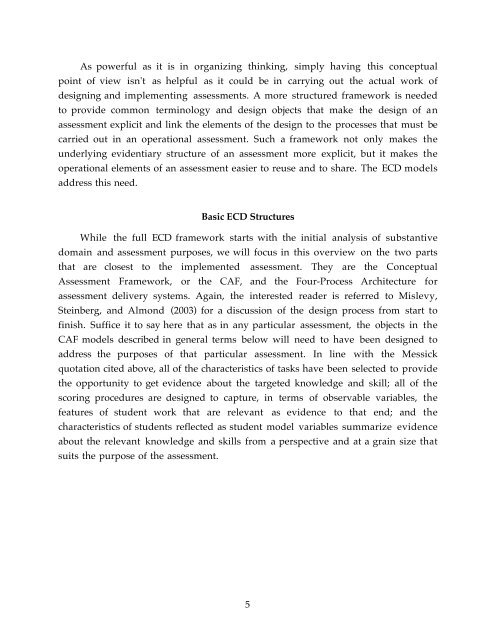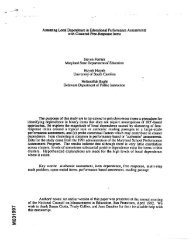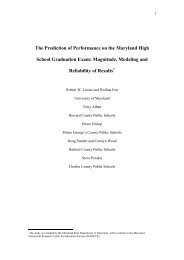A Brief Introduction to Evidence-Centered Design CSE Report 632 ...
A Brief Introduction to Evidence-Centered Design CSE Report 632 ...
A Brief Introduction to Evidence-Centered Design CSE Report 632 ...
Create successful ePaper yourself
Turn your PDF publications into a flip-book with our unique Google optimized e-Paper software.
As powerful as it is in organizing thinking, simply having this conceptualpoint of view isn't as helpful as it could be in carrying out the actual work ofdesigning and implementing assessments. A more structured framework is needed<strong>to</strong> provide common terminology and design objects that make the design of anassessment explicit and link the elements of the design <strong>to</strong> the processes that must becarried out in an operational assessment. Such a framework not only makes theunderlying evidentiary structure of an assessment more explicit, but it makes theoperational elements of an assessment easier <strong>to</strong> reuse and <strong>to</strong> share. The ECD modelsaddress this need.Basic ECD StructuresWhile the full ECD framework starts with the initial analysis of substantivedomain and assessment purposes, we will focus in this overview on the two partsthat are closest <strong>to</strong> the implemented assessment. They are the ConceptualAssessment Framework, or the CAF, and the Four-Process Architecture forassessment delivery systems. Again, the interested reader is referred <strong>to</strong> Mislevy,Steinberg, and Almond (2003) for a discussion of the design process from start <strong>to</strong>finish. Suffice it <strong>to</strong> say here that as in any particular assessment, the objects in theCAF models described in general terms below will need <strong>to</strong> have been designed <strong>to</strong>address the purposes of that particular assessment. In line with the Messickquotation cited above, all of the characteristics of tasks have been selected <strong>to</strong> providethe opportunity <strong>to</strong> get evidence about the targeted knowledge and skill; all of thescoring procedures are designed <strong>to</strong> capture, in terms of observable variables, thefeatures of student work that are relevant as evidence <strong>to</strong> that end; and thecharacteristics of students reflected as student model variables summarize evidenceabout the relevant knowledge and skills from a perspective and at a grain size thatsuits the purpose of the assessment.5






